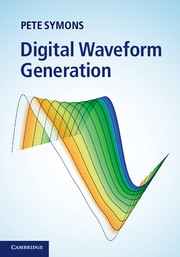Book contents
- Frontmatter
- Contents
- Preface
- Acknowledgements
- Glossary of terms
- 1 Introduction to waveform generation
- 2 The foundations of digital waveform generation
- 3 Recursive sine wave oscillators
- 4 DDS sine wave generation
- 5 DDS arbitrary waveform generation
- 6 Dynamic waveshape and spectrum control
- 7 Phase domain processing – DDS and the IDFT
- 8 Hardware implementation architectures
- 9 Digital to analogue conversion
- Index
- References
2 - The foundations of digital waveform generation
Published online by Cambridge University Press: 05 November 2013
- Frontmatter
- Contents
- Preface
- Acknowledgements
- Glossary of terms
- 1 Introduction to waveform generation
- 2 The foundations of digital waveform generation
- 3 Recursive sine wave oscillators
- 4 DDS sine wave generation
- 5 DDS arbitrary waveform generation
- 6 Dynamic waveshape and spectrum control
- 7 Phase domain processing – DDS and the IDFT
- 8 Hardware implementation architectures
- 9 Digital to analogue conversion
- Index
- References
Summary
We begin this chapter by reviewing some important mathematical principles that underpin digital waveform generation. We then proceed to introduce and develop a concept which is central to this book – sampling a tabulated signal – and an associated concept – the wavetable. After introducing the wavetable as a fundamental building block, we consider several methods for specifying an arbitrary waveform function that is tabulated within it.
Section 2.4 introduces phase accumulation frequency synthesis and phase–amplitude mapping based upon wavetable lookup as the foundations of what we call generalised direct digital synthesis (DDS). This section also outlines some important error mechanisms that are fundamental to the technique, and whose mitigation is the topic of later chapters.
We conclude this chapter by reviewing the principal control parameters of a digital waveform generation system against their ideal characteristics. Finally, we define some qualitative performance metrics that we use in later chapters to investigate the effects of design and control parameter changes using computational simulation of a mathematical model. These metrics are also used to compare different waveform generation algorithms under identical control parameter conditions.
Mathematical preliminaries
In this section we briefly review some important mathematical concepts which underpin the generation of electronic signals by digital means, particularly those based upon phase accumulation and phase–amplitude mapping (i.e. DDS). Our objective is to provide a sufficiently detailed review to enable an understanding of the concepts presented in later chapters. We begin with a review of continuous and discrete-time signals.
- Type
- Chapter
- Information
- Digital Waveform Generation , pp. 49 - 89Publisher: Cambridge University PressPrint publication year: 2013



